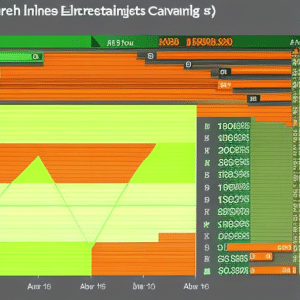The ethereal ether of Ethereum has become a driving force in the cryptocurrency market. With its promise of decentralization, scalability, and interoperability, investors have been drawn to this digital asset as a way to diversify their portfolios. Understanding how Ethereum’s price is determined can allow investors to make more informed decisions about their investments. This article will analyze the various drivers that influence Ethereum’s pricing, from supply and demand forces to macroeconomic factors. By examining these aspects carefully, investors can better understand what influences the price of Ethereum and make more strategic investment decisions.
Key Takeaways
- Supply and demand forces, speculation, and investor sentiment play a crucial role in influencing Ethereum’s price.
- Understanding and monitoring the Fear and Greed Index, as well as market sentiment, is essential for predicting changes in Ethereum’s price movements.
- Regulations, taxation policies, and policies related to digital assets can impact Ethereum’s price and investor confidence.
- Technological advancements, institutional investments, and global events also have significant effects on Ethereum’s price.
Supply and Demand
Supply and demand is an essential factor affecting the price of Ethereum, akin to the way a hand pulls a puppet’s strings. Speculation has shown itself to be an important driving force in the cryptocurrency market, particularly when it comes to Ethereum. When investors speculate on the future price, they can drive up demand for coins, thus increasing their value. Similarly, when prices are high due to speculation, traders who have previously purchased coins may decide to sell them off quickly in order to capitalize on their gains – resulting in decreased liquidity and therefore lower prices. Additionally, liquidity issues can affect Ethereum prices since too much or too little supply may lead to imbalances that could cause drastic changes in its value over time. Market sentiment is also an important factor when it comes to determining Ethereum’s price movements as investor sentiment can shift rapidly with news or events related to the coin.
Market Sentiment
Market sentiment is an important factor in determining the price of Ethereum. The Fear and Greed Index, which measures investors’ emotions regarding investment risks, can be used as a gauge of market sentiment. Additionally, investor confidence also plays a role in dictating how much investors are willing to invest into Ethereum. By understanding these key indicators of market sentiment, one can gain insight on possible future movements in the price of Ethereum.
Fear and Greed Index
The Fear and Greed Index is a metric used to assess the sentiment of cryptocurrency traders in order to predict their behavior. Specifically, this index compares data points such as volatility, market momentum, volume trading and social media trends between various cryptocurrencies to measure fear or greed among investors. For example, if the index reveals that traders are exhibiting fear-based trading by selling cryptoassets quickly without due consideration for potential returns, then it can be assumed that this will have an adverse effect on Ethereum prices. Conversely, when investors demonstrate greed-based investing by buying into Ethereum with excessive optimism regardless of any market indicators or warnings from analysts, this could lead to Ethereum’s price increasing significantly. As such, the Fear and Greed Index serves as an important tool for understanding investor confidence in Ethereum and other cryptocurrencies. This helps explain how changes in investor sentiment can cause significant fluctuations in Ethereum prices over time.
As such, understanding the Fear and Greed Index is essential for predicting changes in Ethereum price drivers moving forward. Consequently, stakeholders including traders and analysts should remain mindful of these factors when making decisions related to cryptocurrency investments.
Investor Confidence
Analyzing the Fear and Greed Index can provide an illuminating window into investor confidence in the cryptocurrency sphere, offering a glimpse of how sentiment shifts can dramatically affect its trajectory – like a rollercoaster ride. As with any type of investment, understanding investor behaviour is essential to success; financial literacy and sound trading strategies are key components for anyone interested in investing in Ethereum. The Fear and Greed Index allows investors to confidently follow through on their decisions by giving them insight into the current market conditions.
The index also serves as an indicator of investor sentiment, providing valuable information about Ethereum’s performance based on the collective opinion of its users. This means that even if one individual has a poor experience with Ethereum, they can still rely on the collective voice of others who are more confident in its potential. By recognizing changes in sentiment over time, investors can be better prepared to adjust their own trading strategies accordingly, granting them greater control over their investments when engaging with Ethereum markets. Ultimately, this paints an accurate picture of the current market state—a necessary tool for any serious trader looking to capitalize on Ethereum’s price movements. With this knowledge in hand, traders will be better equipped to make informed decisions about their investments—and thus help drive the price of Ethereum further up or down depending on investor confidence. Transitioning from here we examine how regulations and policies around cryptocurrencies such as ethereum may play into pricing dynamics.
Regulations and Policies
Regulations and policies can have a significant impact on the price of Ethereum. Taxation policies, in particular, can affect investor sentiment and liquidity issues associated with Ethereum. For instance, taxation laws that are advantageous to investors can increase their confidence in investing in Ethereum, leading to higher prices. Conversely, unfavorable tax laws or taxes imposed on profits generated from cryptocurrency investments can lead to investors being discouraged from buying Ethereum, thus reducing demand and causing its price to fall. In addition, regulations related to the usage of digital assets can also influence investor confidence since they may affect the utility of Ethereum or other cryptocurrencies as a means of payment or store of value. Thus, any changes in taxation or regulations concerning digital assets must be closely monitored by investors for potential impacts on the price of Ethereum.
The technology adoption rate is another factor that affects the price of Ethereum. An increasing number of businesses and individuals using blockchain-based solutions such as smart contracts and decentralized applications (dApps) powered by Ethereum will increase its market capitalization and thus its price. Furthermore, advancements in scalability solutions for Ethereum could lead to increased use cases for the network which would further drive up its value over time. As such, it is important for investors to stay informed about technological developments related to the platform that could potentially influence its future performance.
Technology Adoption
Adoption of blockchain-based solutions such as smart contracts and decentralized applications can significantly impact the market capitalization of digital assets like Ethereum. Such technological innovation has the potential to open new avenues for developers, businesses and investors alike. For example, Ethereum’s user interface aims to make it easier for users to build and deploy distributed applications on its platform. This could attract more users to the network with their own innovative ideas, leading to wider adoption of the technology and potentially driving up demand for ETH tokens. Moreover, these developments have a knock-on effect on institutional investment as they increase confidence in Ethereum’s long-term prospects. As more organizations become aware of its potential, companies may be encouraged to allocate resources towards researching its use cases and exploring new ways to harness its power. By doing so, institutions are likely to contribute towards increasing the value of Ethereum in both the short and long term. Transitioning into this space, institutional investments may provide additional support for ETH prices should they continue along this trajectory.
Institutional Investment
Investigating the impact of institutional investment on blockchain-based solutions can provide valuable insight into the potential of these technologies. As the industry trends toward greater global reach, more and more institutional investors are beginning to recognize the potential for a return on their investments in Ethereum. This has been demonstrated by new entrants into the market such as Fidelity Digital Assets, Morgan Creek Digital, Bakkt, and ErisX. These firms represent a growing trend of institutions entering into this nascent market with an eye towards long-term growth.
The influx of institutional money has resulted in increased liquidity for Ethereum and other digital assets while providing more stability to prices. The ability of institutions to make long-term investments mitigates some volatility risk that is inherent in digital asset markets, creating an environment where participants can make decisions based on fundamentals rather than short-term speculation or technical analysis. By understanding how institutional investment affects Ethereum prices, it is possible to better assess its potential as an attractive asset class for future growth. With this in mind, it is important to consider how interest rates may also influence price movements within this space.
Interest Rates
The impact of interest rates on the overall performance of blockchain-based solutions is an important factor to consider when examining market dynamics. Changes in interest rates can have a direct effect on cryptocurrency markets, as well as other technology projects that rely on blockchain infrastructure. This is due to the political influence of central banks and economic trends that can affect the supply and demand for digital assets. Low interest rates tend to lead to increased investment in cryptocurrencies, while high interest rates can reduce demand. As such, it is essential for investors and industry participants alike to keep an eye on global monetary policy and how changes in interest rates may impact their investments. In conclusion, understanding how fluctuations in interest rate policies can affect the Ethereum price will help traders make informed decisions about their portfolios. Transitioning now to network activity, it is clear that this plays a key role in determining Ethereum’s value proposition over time.
Network Activity
Analyzing network activity is essential for understanding the performance of blockchain-based solutions and their associated digital assets. Network activity serves as an indicator of user engagement and can be used to measure the market sentiment of trading participants. Speculation trends, liquidity flows, and transaction fees are all key metrics when considering price drivers in the Ethereum network. When these metrics show increased activity, it can signal a rise in prices due to higher demand for Ethereum tokens. Conversely, decreased network activity may indicate that prices will fall due to a lack of demand or speculation.
In addition to measuring network activity, analyzing media coverage plays an important role in determining Ethereum’s price movements. The influx of new users from media coverage can lead to more buying pressure which drives prices up as supply is exhausted by buyers. Moreover, positive news about Ethereum’s technology or applications often leads to bullish sentiment among investors. On the other hand, negative news can have a bearish effect on Ethereum prices as investors become discouraged and sell off their holdings.
Media Coverage
Media coverage can have a significant impact on digital asset trading sentiment and market dynamics. Alternative media outlets are known to cover the cryptocurrency space more than traditional news networks, often influencing the public’s views of different projects. Additionally, celebrity endorsements from well-known figures can also sway people into buying into certain projects, leading to an increase in demand for those assets. As a result, this has been observed to cause spikes in price as the increased attention causes buyers to enter the market and purchase tokens or coins. However, it is important to note that this type of price movement is not sustainable as it can easily be reversed when the hype around the project fades. Inflation is another factor that affects Ethereum prices over time.
Inflation
Inflation can have an insidious influence on digital asset trading, drastically altering market dynamics and impacting sentiment. In particular, the Ethereum network is subject to fluctuating levels of inflation due to its consensus algorithm. This creates a context in which speculation and other financial instruments are used to manage risk levels. Firstly, when inflation is high it typically causes the Ethereum price to dip as investors become more bearish about future returns. Secondly, deflationary forces can cause prices to go up as there is less supply of ETH available for purchase. Lastly, changes in the overall macroeconomic environment can also affect the value of Ethereum as new economic conditions create different incentives for buyers and sellers alike. All these factors combine together to form a complex picture that determines the price drivers of Ethereum.
Real-World Use Cases
Real-world use cases for Ethereum are becoming increasingly prevalent, demonstrating the innovative potential of a blockchain-based application. Cryptocurrency exchanges are one major example, as they often rely on Ethereum’s technology to facilitate secure transactions between buyers and sellers. Tokenized assets are also being developed using Ethereum, allowing users to trade digital versions of real-world commodities such as gold or stocks. These applications have become increasingly popular among investors and traders alike, as they provide an easy way to access the cryptocurrency market without having to purchase outright coins or tokens. As more people become involved in these types of activities, Ethereum’s price is likely to rise due to increased demand for its services. By understanding how investor behavior affects the price of Ethereum, it becomes possible to anticipate future developments in the industry.
Investor Behavior
Investor behavior is often likened to the surging and ebbing of an ocean, with its unpredictable fluctuations affecting the value of digital assets, such as Ethereum. Social media plays a large role in influencing investor sentiment and market prices, with positive news pushing prices higher while negative news sends them lower. Trading bots have also been found to be increasingly influential on Ethereum pricing, as these automated programs can anticipate market movements more quickly than human traders can respond. As a result, investors must take into account not only traditional macroeconomic factors but also the impact of social media and trading bots when attempting to predict Ethereum pricing. These technical factors may play an even larger role in Ethereum pricing in the future, making it essential that investors stay informed and keep up with changes in technology. With this understanding of how investor behavior affects Ethereum price drivers, we can now move onto exploring macroeconomic factors.
Macroeconomic Factors
Investor behavior is an important factor in determining the price of Ethereum, but macroeconomic factors are also significant. Political and global events can have a major impact on Ethereum pricing as investors respond to news and uncertainty.
The three main macroeconomic factors that affect Ethereum prices include:
- Political Fluctuations: Political instability or changes in policy can cause investors to become uncertain about the future of the asset, leading them to buy or sell accordingly.
- Global Events: Major news events from around the world can also influence investor sentiment and thus dictate whether they will buy or sell Ethereum.
- Interest Rates: Interest rates set by central banks play a role in influencing the amount of money available for investment, which in turn affects cryptocurrency prices like Ethereum.
Overall, macroeconomic conditions such as political fluctuations, global events, and interest rates are all important drivers of Ethereum’s price movements. With this understanding, miners can better anticipate market trends and make informed decisions regarding their investments. From here we move onto crypto mining – how it works and why it is essential for digital currency networks like Ethereum.
Crypto Mining
Crypto mining is an essential process for digital currency networks, such as Ethereum, to facilitate transactions and issue new units of currency. The process involves miners competing to solve cryptographic puzzles in order to add new blocks of data onto the blockchain. This decentralization debate has been a major factor driving the price of Ethereum as it allows for more trustless and secure transactions. In addition, scalability has been another major topic within the crypto mining space due to the increasing demand for more efficient blockchains that can handle larger volumes of transactions at a low cost. As this debate continues, it is expected that Ethereum’s price will experience fluctuations based on how these issues are addressed. Ultimately, crypto mining remains an integral part of ensuring reliable and secure transactions on the Ethereum network while also influencing its current price.
Scalability
The scalability of digital currency networks is a hotly contested topic, as it has the potential to unlock massive amounts of economic growth; however, it also requires careful consideration to ensure that transactions can be processed quickly and securely. To achieve this, Ethereum is able to leverage various technologies:
- Smart Contracts: Smart contracts are self-executing pieces of code that are executed on the Ethereum blockchain. These contracts enable users to securely exchange assets such as money or property without requiring intermediaries. This allows for faster and more decentralized transactions than traditional methods.
- Tokenization Platforms: Tokenization platforms allow users to create their own tokens based on Ethereum’s blockchain technology which can be used for payments and other financial services. Tokens can also be used as a form of collateral in order to secure loans or investments in projects. This increases liquidity and facilitates greater capital flow into the Ethereum ecosystem.
- Interoperability: Interoperability between different blockchains is essential for ensuring scalability across digital currencies networks. This allows users to move funds between different blockchains quickly and securely, allowing them to take advantage of the best features offered by each network while avoiding any potential risks associated with single chain systems. With increased interoperability comes increased scalability which will ultimately lead to increased adoption of digital currencies worldwide.
Through smart contracts, tokenization platforms, and interoperability, Ethereum has been able to increase its scalability significantly over time which has resulted in an increase in its price due its use case value proposition being realized by investors worldwide. As such, these technologies have been major drivers behind Ethereum’s price movements over recent years and will continue playing an important role going forward into the future as well. Interoperability then serves as a key factor in enabling seamless integration between multiple blockchains so that transactions can be carried out efficiently across multiple ecosystems simultaneously thus providing further impetus for Etheruem’s price appreciation moving ahead.
Interoperability
Interoperability between different blockchains is essential for unlocking the potential of digital currencies networks and creating a secure, efficient, and global financial system. Smart contracts are one of the most important components enabling such interoperability. They allow for the execution of transactions across different blockchains, allowing users to access services on other platforms without having to switch wallets or learn new languages. This type of interoperability makes it possible for decentralized finance (DeFi) products to be used across multiple blockchains, providing users with increased flexibility and efficiency while reducing transaction costs. As more DeFi projects are developed, they will need to connect with other blockchains in order to reach their full potential. Interoperability can thus have a significant impact on Ethereum prices by increasing demand as the network gains greater access to more markets and services.
Frequently Asked Questions
How does Ethereum compare to other cryptocurrencies?
Comparing Ethereum to other cryptocurrencies, it is like a wild stallion amongst horses: its utility value and token liquidity make it stand out. Analytically, Ethereum has advantages over other cryptos in terms of speed, scalability, and security. Thus, making it an attractive choice for investors.
What are the risks associated with investing in Ethereum?
Investing in Ethereum carries significant risks due to its price volatility and uncertainty surrounding potential regulatory actions. This makes it a higher-risk investment than some other cryptocurrencies.
How does Ethereum fit into a diversified portfolio?
Incorporating Ethereum into a diversified portfolio can provide strategic investment benefits, such as diversification and risk mitigation. By allocating funds across multiple asset classes and currencies, investors can optimize their return on investment while reducing volatility.
What is the expected return on an Ethereum investment?
It is impossible to definitively predict the return on any investment, Ethereum included. Technical Analysis and Network Effects offer insight into the potential of such investments. Consideration of these factors must be weighed against Ethereum’s price drivers for a comprehensive evaluation of its expected return.
How do macroeconomic factors affect Ethereum’s price?
The macroeconomic factors of regulation and supply/demand have a significant impact on Ethereum’s price. Changes in these areas can affect the market, potentially causing spikes or dips in prices relative to demand. Analyzing the effects of each factor is important for understanding how volatile Ethereum pricing can be.







